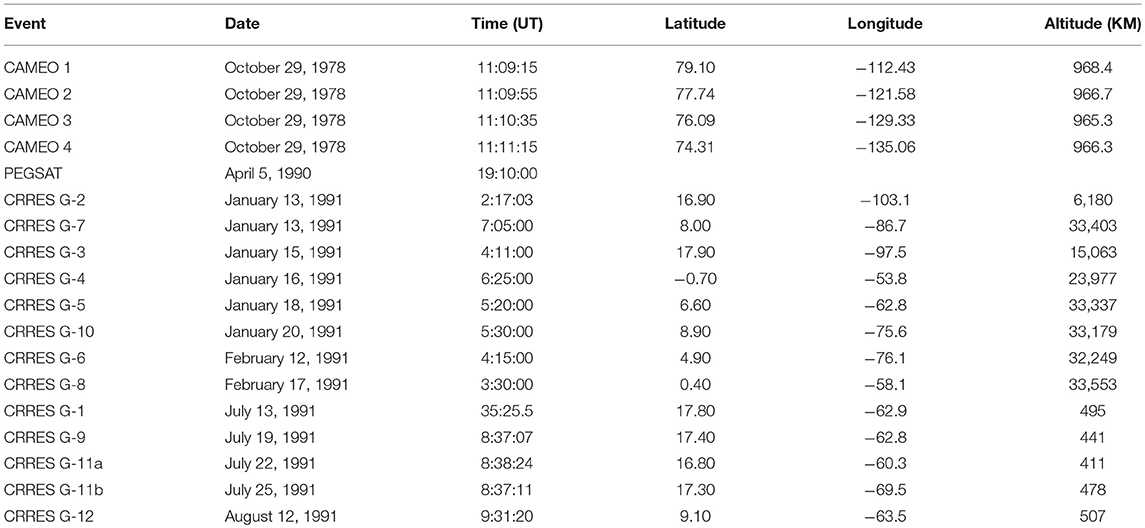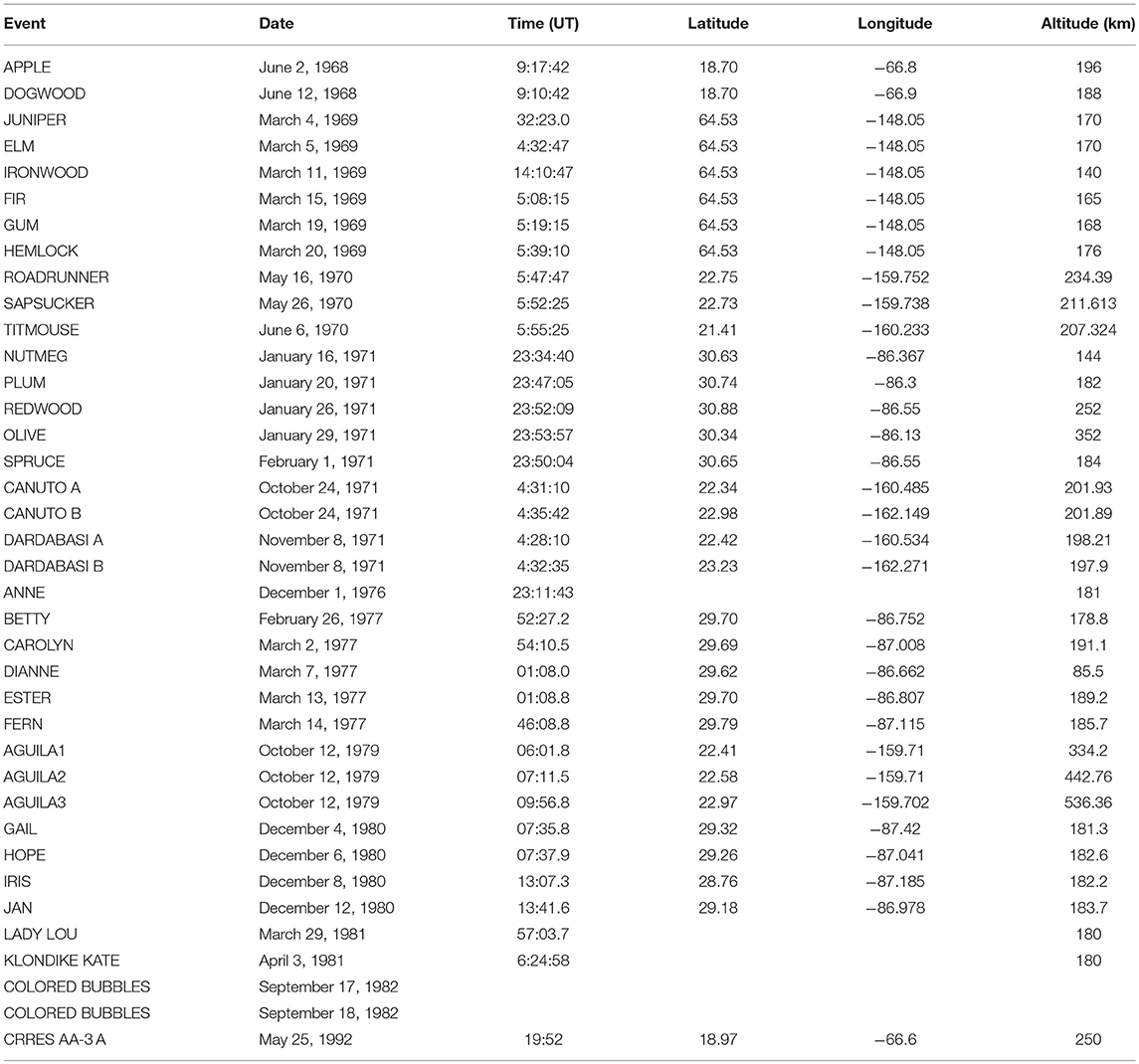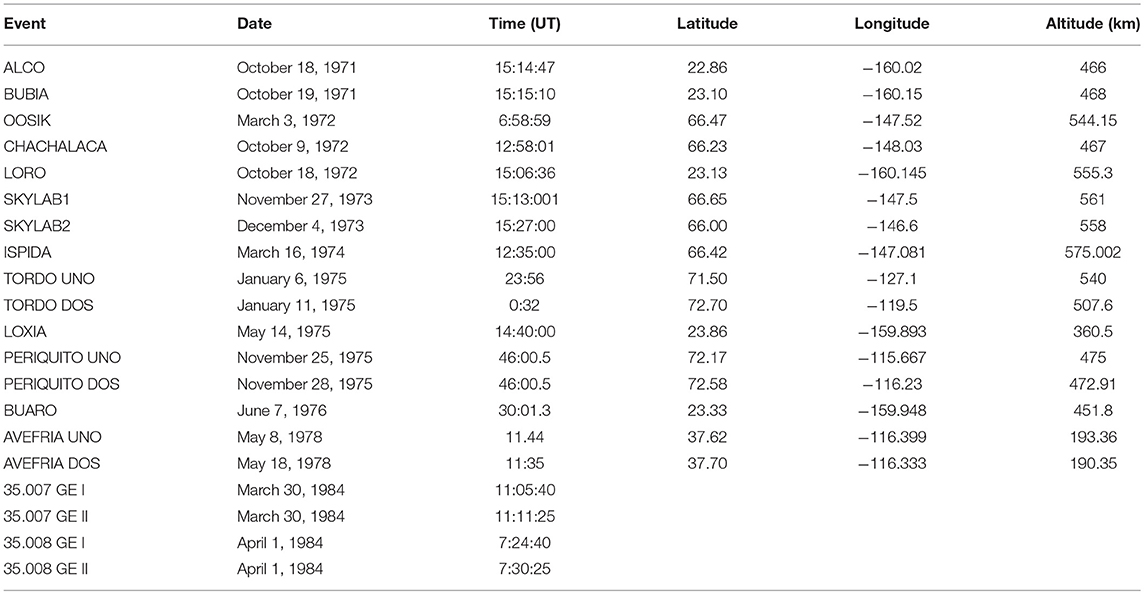- Los Alamos National Laboratory, Los Alamos, NM, United States
Los Alamos has a long history of participation in active experiments in space beginning with the Teak nuclear test in 1958. Above-ground nuclear testing stopped in 1962 because of the Partial Test Ban Treaty, and a program of non-nuclear chemical release experiments began in 1968. Los Alamos has participated in nearly 100 non-nuclear experiments in space, the last being the NASA-sponsored strontium and europium doped barium thermite releases in the Arecibo beam in July of 1992. The rationale for these experiments ranged from studying basic plasma processes such as gradient- driven structuring and velocity-space instabilities to illuminating the convection of plasmas in the ionosphere and polar cap to ionospheric depletion experiments to the B.E.A.R. 1-MeV neutral particle beam (NPB) test in 1989. This report reviews the objectives, techniques and diagnostics of Los Alamos participation in active experiments in space.
Introduction
A request to give a talk at the “Active Experiments in Space: Past, Present and Future” conference in Santa Fe in September 2017 motivated the research behind this report. We were asked to summarize LANL involvement in active experiments (http://www.cvent.com/events/active-experiments-in-space-past-present-and-future/event-summary-73675ac6ba5745d48d181933c4783454.aspx). The previous summary paper on LANL-related active experiments is out of date [1]. At Los Alamos active experiments have been somewhat of a stepchild to all the wonderful discoveries made by LANL satellites beginning with the VELA satellites. However, active experiments play a complementary role to the exploration satellites. The hypotheses testing active experiments play a “Galileo” role in space science while the instrumented satellites and rockets play a “Christopher Columbus” discovery role.
This report is a “history” and not a description of a scientific investigation. We begin with the people involved over the years because as you get older those are the associations you cherish. Then of course we need to identify the funding sources for our active experiments. Next, we present a “catalog” describing the timeline and locations of the many active experiments with Los Alamos involvement. Following this, we describe the various active experiment techniques and diagnostics we've employed. Next, we briefly describe the many objectives of these experiments. Lastly, we close with a few examples of our active experiments. An extensive bibliography provides additional detail and experiment results.
The People
For most of these experiments Los Alamos has not acted alone. Early on we partnered with our fellow AEC laboratory Sandia; they had the rockets and we had the shaped- charges and cameras. Many suggestions for experiments and facilities and diagnostics came from our partners at the University of Alaska's Geophysical Institute. A number of the experiments studied auroral phenomena and our Canadian partners provided launch support and diagnostics. Over the years we have also partnered with EG&G, the Naval Research Laboratory, the Aerospace Corporation, the Lockheed Palo Alto Research Laboratories, Goddard Space Flight Center, the Max Planck Institute and others.
We've had the privilege of working with many great folks over the years. We begin with an “In Memoriam” tribute to Gene Wescott. Eugene Michael “Gene” Wescott (February 15, 1932–February 23, 2014) was an American scientist, artist, and traditional dancer. Wescott worked at the Geophysical Institute of the University of Alaska Fairbanks from 1958 to 2009. He was appointed Professor Emeritus of Geophysics, and had an extensive background of research in solid earth geophysics and space physics. He was directly involved in auroral and magnetospheric electric field studies and plasma physics experiments using barium and calcium plasma rocket injections at Poker Flat Research Range. In the marriage between the Geophysical Institute and the AEC, Gene had the range and the ideas and the AEC had the rockets, the aircraft, and the shaped-charges.
The Los Alamos Scientific Laboratory, Los Alamos National Scientific Laboratory and Los Alamos National Laboratory (LASL/LANSL/LANL) involvement in many of the early active experiments originated in Group J-10. J-10 group leaders Herman Hoerlin, Milt Peek and Bob Jeffries supported the active experiments. Their successors in leading other LANL organizations including Doyle Evans, Don Cobb, and David Simons continued LANL support for active experiments in space. Their support was especially important in securing funding for active experiments. Many LANL staff members and technicians (Casey Stevens, Lois Dauelsberg, Hal Fishbine, Hal Dehaven, John Wolcott, Bob Carlos, Paul Bernhardt, and Gordon Smith to name just a few) were vital to our success. Special recognition goes to Mel Duran and the others manning an optical observatory in the dead of winter at Resolute Bay, NWT, Canada, during the Tordo and Periquito experiments.
It wasn't all cold weather either. Special thanks to the crew of the Beam Experiments Aboard a Rocket (B.E.A.R.) experiment conducted in summer heat of at the White Sands Missile Range in 1989. Of course, we conducted many experiments with our Sandia National Laboratory in the Hawaiian Islands. We also benefitted from the many interactions with our fellow Principal Investigators (PIs) in the NASA-sponsored Combined Release Radiation Effects Satellite (CRRES). A special acknowledgment to NASA's CRRES leader, David Reasoner.
The Money
Of course, we didn't get to conduct all these fun experiments without money. The Department of Defense and Atomic Energy Commission funded the very earliest Los Alamos high-altitude nuclear tests. Then for many years a provision of the 1963 Limited Test Ban Treaty provided funds. As part of Safeguard C of 1963 Limited Test Ban Treaty, the AEC and its successors maintained ships, labs, rockets, aircraft, and a “dedicated staff” to enable the Government to resume testing nuclear weapons in the atmosphere. From a professional point-of-view this funding had the disadvantage that the goal was not to carefully document the results of the experiments. We had to scramble to develop experiment plans for the next exercise.
Over the years Los Alamos has also received funding from NASA and the Defense Nuclear Agency. Our experience with active experiments resulted in Los Alamos being funded by the Strategic Defense Imitative Office to conduct the B.E.A.R. project in the 80's.
Catalog
We used the word “catalog” to describe our involvement in active experiments; this report will not describe all of them. They begin with the Teak nuclear test in 1958 and end with the NASA-sponsored CRRES experiments in 1992. Los Alamos has been involved with 107 active experiments in space, not including any RF modification experiments.
Table 1 shows the dates and locations of LANL-involved nuclear tests in space. Los Alamos involvement began with the “TEAK” nuclear test on August 1, 1958 when the author was in high school. Table 2 shows the dates and locations of LANL-involved thermite releases from orbit. “Thermite” releases will be described in the section on techniques. Table 3 shows the dates and locations of LANL-involved thermite releases from rockets. Table 4 shows the dates and locations of LANL-involved shaped-charge barium injections.
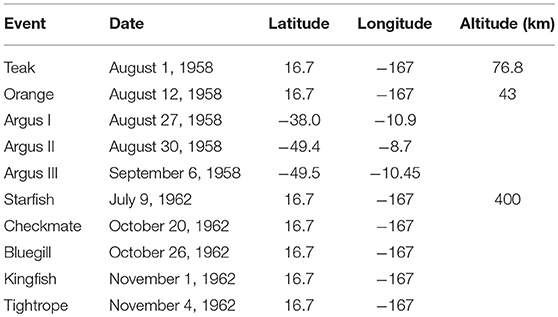
Table 1. Dates and locations of LANL-involved nuclear tests in space [2].
The tables show that we conducted experiments over a wide range of altitudes. This “catalog” does not have the experiment altitude for a number of experiments. The altitude of the experiments ranged from 43 km for the ORANGE test to 33,553 km (over 5 Re) for the CRRES G-8 release.
The tables also show that we conducted experiments over a wide range of latitudes and longitudes. They range in longitude from Johnston Island in the Pacific to the Argus nuclear tests in the South Atlantic. Our experiments range in latitude from the South Atlantic Argus tests to Cape Parry in Canada's Northwest Territories. Los Alamos has been everywhere!
Techniques
Los Alamos has employed a wide variety of techniques to conduct active experiments in space. These include explosions such as the Argus nuclear tests and the Waterhole experiments use of high explosives to inject molecules into the F-region ionosphere. High explosives are more efficient that just dumping liquid water. Los Alamos pioneered the use of shaped charges to vaporize and inject barium vapor. The charges had nickel-lined barium cones and generated barium jets with speeds up to 14 km/s. Los Alamos also conducted the granddaddy of all particle injections with the 1- MeV neutral particle B.E.A.R. beam. Los Alamos also conducted the more traditional thermite and sulfa-hexa-fluoride release experiments.
Nuclear Tests
It would be dismissive of the courage and dedication of those involved to write that the technique for the Los Alamos-related nuclear tests involved putting a nuclear device atop a Redstone or Thor missile and detonating the device at a preset time after launch. Both the missiles and the devices were experimental. For example, the Bluegill test was actually Bluegill triple prime because of missile malfunctions on the first three attempts.
Thermite Barium Releases From Sounding Rockets
Barium vapor released from thermite canisters was the most common active experiment technique. The barium vapor was produced by the exothermic reaction of a pressed mixture of barium metal chips and cupric oxide powder. The normal mixture ratio was 2.5 moles of barium per mole of cupric oxide with an addition of 1.8 percent by weight of barium azide (see “Chemical Releases from Space Shuttle Payloads,” Thiokol, Wasatch Division, Ogden, Utah, NAS 5-24052, May 1975). Titanium-boride thermites have also been used. Neutral barium atoms evaporate from the hot barium vapor droplets.
The neutral barium expands as a shell centered on the velocity of the release canister. The shell expands with a speed of order 1 km/sec and a thickness of order 0.25 km/sec [3]. Barium was chosen because in sunlight the neutral barium atom's photoionization time constant is roughly 20 s and both neutral barium atoms and ionized barium resonantly scatter sunlight allowing for remote optical sensing of both species [see [4]]. When the canisters are released from sounding rockets at thermospheric altitudes with essentially no directed velocity the resultant barium ion densities can be quite high. Gonzales [5] reported ion densities approaching 107/cm3 for hours after the HOPE release at 182 km). This technique is limited because the releases must occur in twilight when the canister is in sunlight and the optical observations are in darkness.
Shaped-Charge Injections
From a basic physics point-of-view the sounding rocket release were excellent for mapping ionospheric winds and electric fields, but they were inadequate for tracing magnetic field lines above the thermosphere. With the encouragement of Gene Wescott from the University of Alaska's Geophysics Institute, Los Alamos pioneered the use of shaped charges to vaporize and inject barium vapor. The charges had nickel-lined barium cones and generated barium jets with speeds up to 14 km/s and the barium ions could be observed well into the magnetosphere. Another useful feature of the shaped charge injections was that not all the barium was accelerated and a “stay behind” cloud could be tracked to test for altitude effects on field line convection (and equipotentiality). The Alco, Bubia, and Loro experiments were LANL's first use of barium shaped-charges [6].
Thermite Barium Releases From Orbit
When we learned that Jim Heppner from Goddard Space Flight Center planned the CAMEO (Chemically Active Materials Ejected from Orbit) releases we suggested that we could track the barium from the lower forty-eight. We pointed out that barium released at orbital velocity would have sufficient perpendicular (to B) velocity that the magnetic mirror force would accelerate the barium ions upwards along the geomagnetic field. The physics underlying this technique is well-documented in Heppner et al. [7].
Ammonium Nitrate/Nitro-Methane Explosions
Following Mike Mendillo's paper on the effects of the Skylab launch in May, 1973 [8] we decided to try to duplicate the chemistry attributed to have caused the ionospheric hole. The observations were interpreted in terms of exceptionally enhanced chemical loss rates due to the molecular hydrogen and water vapor contained in the Saturn second-stage exhaust plume.
The F-region ionosphere is dominated by atomic ions (mostly O+). When molecules are added to the mix there are rapid charge-exchange/dissociative recombination reactions that remove the ions and electrons producing an ionospheric “hole.”
and then
We began by considering ways to inject water/steam from sounding rocket, even to considering launching hot water heaters. However, a colleague, John Zinn, who had a back ground in explosives pointed out that most explosives produce water and carbon dioxide. So, voila detonate a high explosive in the F-region ionosphere!
After some study of products of detonation from several explosive mixtures considering safety and maximizing the production of molecules, we settled on ammonium nitrate (“fertilizer”) and nitromethane (“nitro” for drag racers) for our test. Fortunately, LANL had experts in producing explosives and they pressed ammonium nitrate into a cylindrical tube. They also calculated the correct stoichiometric mixture of liquid nitro methane to add to the tube on site.
Our initial experiments loaded the ammonium nitrate into aluminum tubes, but concerns about the dangers of falling metal fragments forced us to use plexiglass tubes for later experiments. This caused some consternation for the final Waterhole experiment at Canada's Churchill Research Range in Manitoba. We were able to ship the ammonium nitrate tube and the nitromethane (“cleaning fluid”) separately to be assembled in an underground bunker at the range. Unfortunately, as we were topping off the appropriate amount of nitromethane into the tube it began to leak. After much perspiration and yellow (“rocket tape”) we were able to finish the assembly.
Particle Accelerator
The first particle accelerator flown by Los Alamos was during Operation Birdseed in 1970. The accelerator was a co-axial, neon plasma gun designed by John Marshall and Ivars Henins. The energy delivered to the plasma gun was 350,000 joules at 1,700,000 amperes and a power of 40 billion watts [9]. A number of active experiments in space have employed electron guns, but to my knowledge Los Alamos was not involved in the employment of those devices.
Los Alamos' next venture into the particle accelerator technique came in the 80's at the request of President Reagan's Strategic Defensive Initiative (SDI). Neutral particle beam (NPB) technology was considered to be one of the most promising SDI concepts. The challenge was to fly a Radio Frequency Quadruple (RFQ) accelerator on board a sounding rocket. The accelerator first accelerated negative hydrogen ions to 1 MeV and then passed them through a gas to strip off the electron resulting in a 1-MeV NPB that would propagate across the geomagnetic field [10].
Diagnostics
Diagnostics are the key to successful active experiments. Over the years optical diagnostics have been the backbone of our active experiments. We have employed both ground-based and airborne platforms. The advantage of the airborne platforms is the cloud-free lines of sight to the experiment. The so-called “Readiness to Test” program funded Boeing 707s for airborne optical diagnostics at all three AEC laboratories. Los Alamos has employed in situ diagnostics since the nuclear testing days; the Argus experiments were diagnosed by instruments on Explorer IV. We got back to in situ measurements during the 1976 Buaro shaped charge experiment when Harry Koons measured the electric fields generated by the free energy of the barium ions [11]. Of course, the satellite-borne sensors made crucial diagnostics of the CRRES releases. The original ionospheric depletion experiments, Lagopedo Uno and Dos, in 1977 were measured by ionosondes located on the island of Kauai. Some of the CRRES experiments employed RF diagnostics of the Arecibo facility.
Cameras provided the principal diagnostic for our active experiments. Television cameras provided real-time tracking of barium clouds out to several earth radii distance. Of course, film cameras provided quantitative image data needed for inventories and dimensions. All-sky cameras provided back-ups. Because distant images are faint and we need star background for triangulation we used interference filtered image intensifiers for the barium-related experiments. Rick Rairden's airborne Fabry-Perot allowed us to sense barium ion motions (not just locations) and provided unique confirmation of barium ion magnetization (ions moving toward and away from the sensor). We also fielded spectrographs and photometers.
As the saying goes “A picture is worth a thousand words—and takes gigabits to process!” [see [12]]. Even amateur photographs can provide valuable information. Figure 1 was taken by my daughter on the beach in St. Croix. It shows the dramatic G-9 CRRES release. The neutral barium atoms are imaged by the bright green sphere. The trailing blue light comes from ionized barium. The cloud in this photo also demonstrates the limitations of ground-based optical diagnostics. Figure 2 shows a quantitative measure on ionized barium column density. This image also shows the slight curvature to the back-side of the barium cloud as explained by Delamere et al. [13].
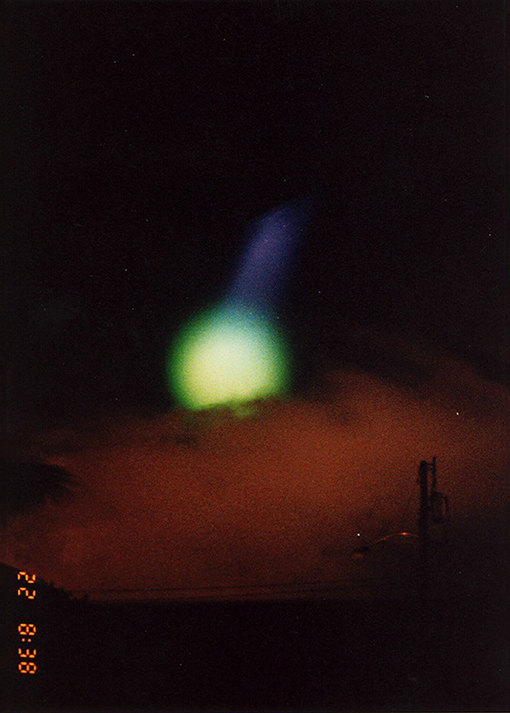
Figure 1. NASA's CRRES G-9 release—amateur's photograph. The CRRES satellite's path is from upper right to lower left. The bright green image is resonantly scattered neutral barium atoms. The ionized barium is the blue streak extending upwards and to the left to the canister release point.
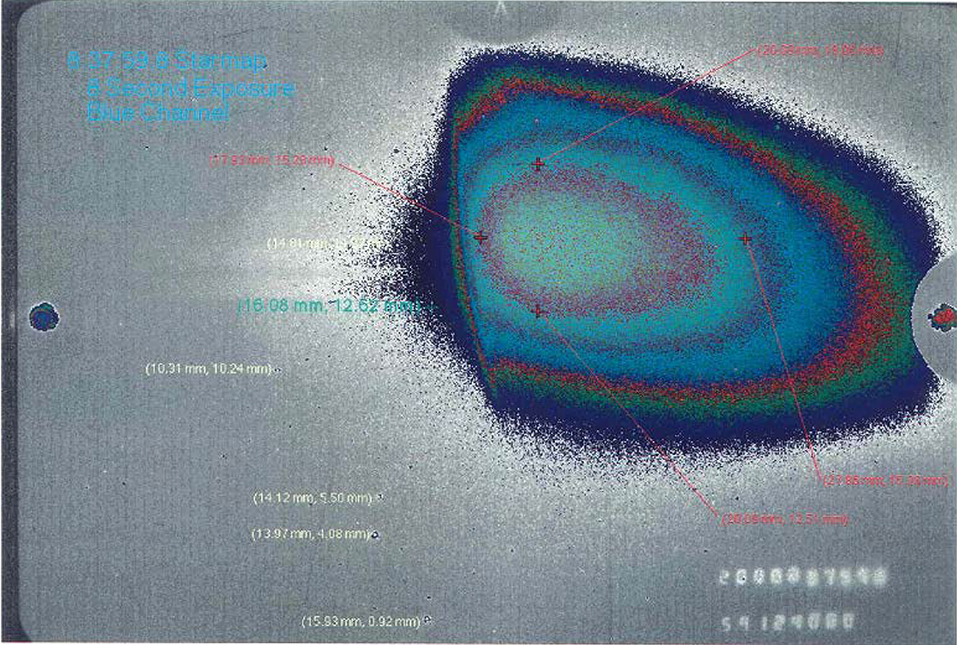
Figure 2. NASA's CRRES G-9 release—BaII (ionized barium) in false color contours. In this view the release satellite had been traveling from left to right. The geomagnetic field appears essentially vertical.
Figures 3, 4 show two examples of the specialized optical diagnostics we employed. Figure 3, from Rairden et al. [14], shows the G-12 barium ion images at three times. On the right we see images from the co-aligned Fabry-Perot instrument. We want to emphasize the middle donut-shaped image. The displacement from the donut hole is a measure of barium ion velocity. The dimple is the first fringe reveals “the double-peaked nature of the ion radial velocity distribution.” Voila—magnetized barium ions!
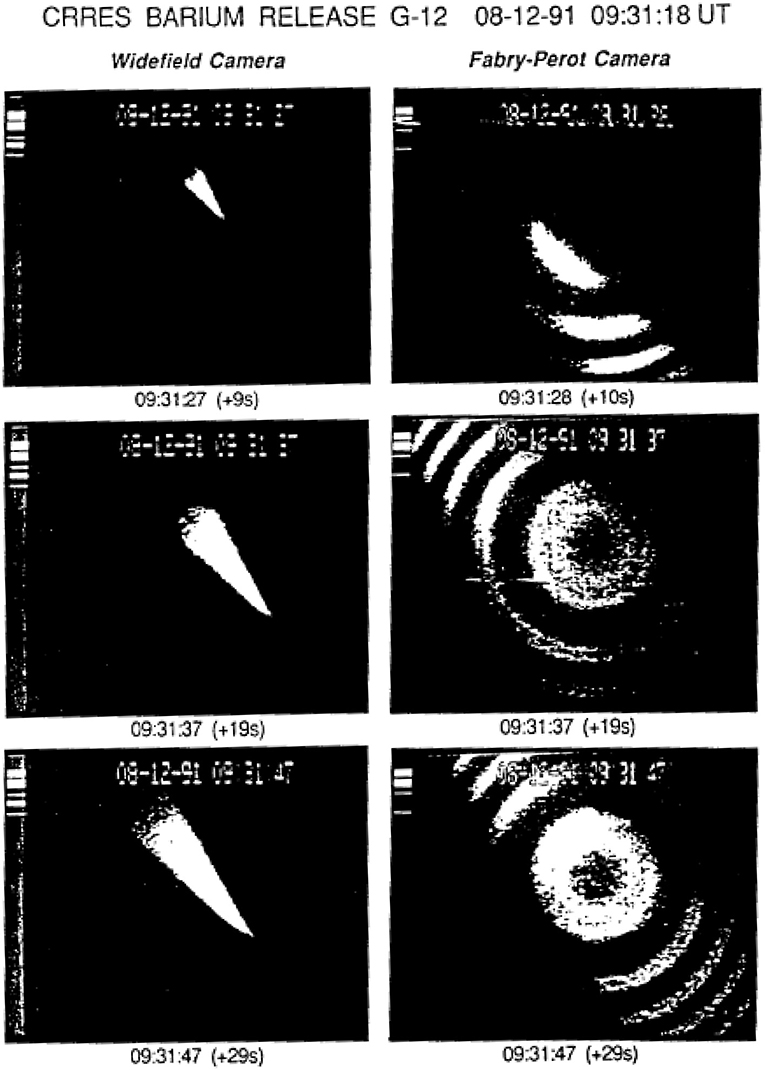
Figure 3. G-12 barium release filtered image sequence. Fringes from the 2-mm Fabry- Perot etalon…reveal the double-peaked nature of the ion radial velocity distribution [14].
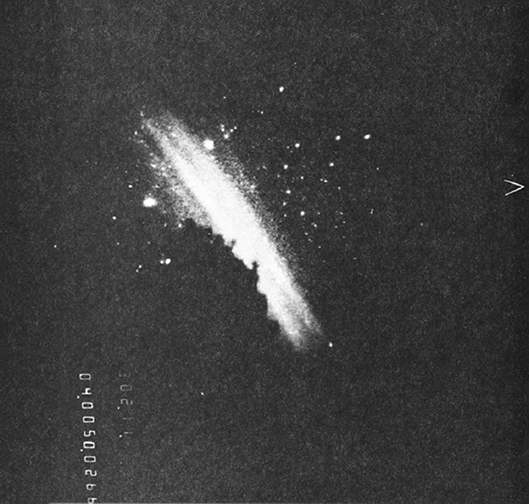
Figure 4. Intensified camera view of release 4 over trees (leftr side) from Table Mountain, California, at 1142 UT. Table Mountain Observatory filtered, intensified camera image of the CAMEO polar cap barium release showing star field and obstruction by tree [Heppner, et al. [7]; reprinted with permission of American Geophysical Union].
The intensified camera image in Figure 4 shows one of the field-aligned CAMEO barium streaks. This image was captured with an interference-filtered intensified camera located at Table Mountain Observatory near Los Angeles, California. The thermite barium release from a satellite occurred over the North Slope of Alaska and the magnetic mirror force pushed the barium ions up the field line to where they were detected thousands of kilometers away. This image also shows another disadvantage of ground-based photography—note the tree obstructing part of the barium streak. In fact, the folks at Table Mountain had their instruments located in the back of a U-Haul truck and had to shove the trackers further toward the back of the truck when the tree became a problem. This demonstrates a unique challenge faced by those diagnosing active experiments—the skill and resources of the experimenter play a role in real-time data acquisition.
We also employed computer modeling of the images. They were helpful in experiment planning to determine camera pointing, field-of-view, and brightness. Computer modeling was also essential in understanding the phenomena being measured.
Objectives
The nuclear tests in space were instrumental in testing device designs, studying weapon effects, and testing delivery systems. The weapon effects included enhanced ionization, diamagnetic cavity formation and collapse, electro-magnetic pulse generation, electro-magnetic wave propagation, atmospheric heave, energetic particle motions and trapping. They were considered for ICBM defense as well as radar blackout studies.
The earliest barium release experiments were used to measure convection electric fields and winds in the ionosphere. Next the shaped-charge experiments were used to illuminate high altitude magnetic field lines and their convection. Injections of energetic barium ions confirmed the magnetic mirror force on ion dynamics.
Then we got more adventurous in our experiment objectives. Active experiments provide unique opportunities to study fluid and kinetic plasma instabilities. Most plasmas encountered in nature are close to equilibrium and not likely to be unstable. With active experiments we can “set the ball at the top of the hill” and watch it fall down. The images in Figure 5 show the “up-the-field-line” images of the Avefria Dos barium cloud. This experiment occurred in Nevada allowing us to position cameras at the foot of the field line. The images show prompt structuring of the energetic barium plasma jet on the left and the slower, Rayleigh-Taylor fluid instability structuring of the “stay behind” barium ions on the right.
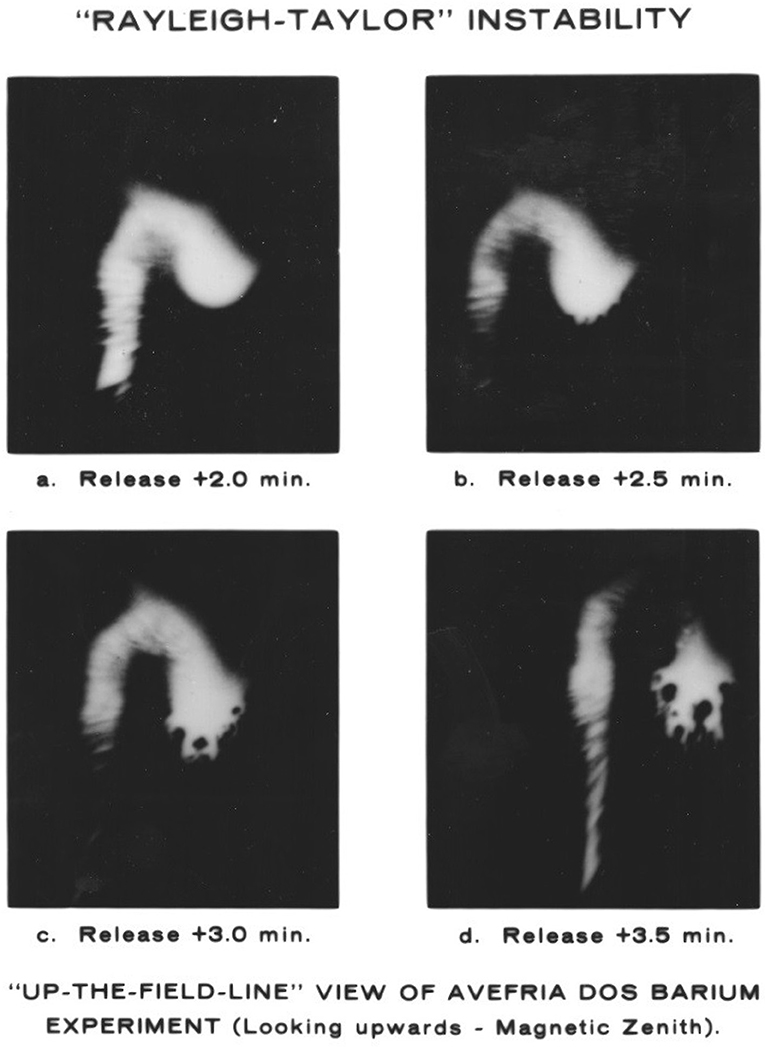
Figure 5. Images of structuring in barium ion clouds. These sequenced “up-the-field line” images show development of a Rayleigh-Taylor instability on the right. The barium ions imaged on the left came from the energetic barium injected by a shaped-charge. That structuring was probably due to a kinetic instability [15].
Figure 6 shows the spectrogram of the field intensities for the G-9 chemical release on July 19, 1991. On the top is the spectrum of the magnetic field fluctuations and on the bottom half we see the spectrum of the electric field fluctuations. This data come from sensors on the CRRES satellite flying through the barium cloud moments after release; the broad-band intensification shown in pink marks the event. The data is from Koons and Roeder [16]. At one time we claimed that our active experiments would make the space plasma “ring like a bell”; the data show predominantly broad-band electrostatic emissions and not bell-like resonant tones.
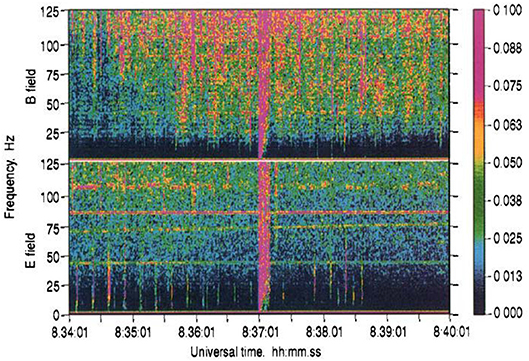
Figure 6. Spectrogram of the field intensities for the G-9 chemical release on July 19, 1991. (Top) Magnetic field; (Bottom) electric field. [[16]; reprinted with permission of American Geophysical Union].
Our active experiment objectives included the study of many additional phenomena. These included Critical Ionization Velocity (CIV) studies—a hypothesis predicted by Hannes Alfven to account for the composition of solar system planets. The critical ionization velocity for a neutral cloud to become ionized is when the relative kinetic energy is equal to the ionization energy. Another objective was to test models of RF propagation through structured plasmas—the PLACES experiments. We also conducted experiments to test the relationship between thermal electron currents and auroral electron precipitation—the Waterhole experiments. We studied the formation of diamagnetic cavities and polarization electric fields in the CRRES experiments. Many of the barium experiments were used to simulate High Altitude Nuclear Explosion (H.A.N.E.) phenomena.
Examples
This review cannot possibly describe all 107 Los Alamos active experiments so we'll use examples to describe the breadth of our work. We begin with the Orange Nuclear Test. Then we show data from the field-line tracing experiments Tordo and Periquito. Following that we'll cover a unique series of the experiments—the Waterhole ionospheric depletion experiments. Then, we'll describe barium releases designed to study RF propagation through structured plasmas and we'll review thermite barium releases at orbital velocity, the CAMEO and CRRES experiments. We'll close with the most energetic particle the B.E.A.R. 10-mA (equivalent), 1-MeV, neutral hydrogen beam.
Orange—Nuclear Weapons Effects Test
The Orange, nuclear weapons effects test, was conducted on August 12, 1958 as part of Operation Hardtack I [17]. The 3.8 megaton device was exploded 43 kilometers above Johnston Island in the Pacific. Figure 7 shows the Orange Event at 1 min after detonation. Note the toroidal yellow or orange colored fireball and white- blue-green-purple air radiation induced glow. This photograph was taken from the deck of an aircraft carrier.
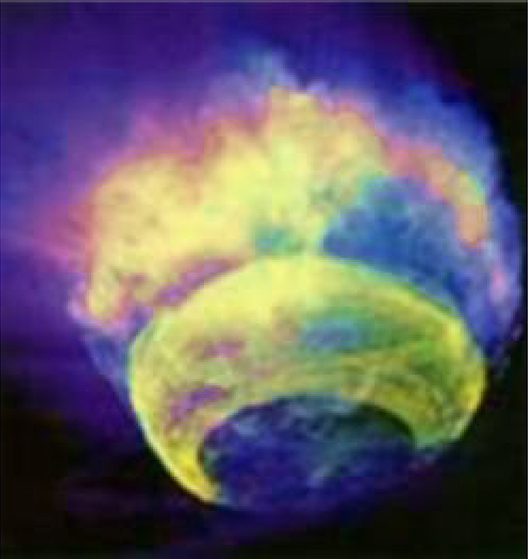
Figure 7. Orange event: toroidal yellow or orange colored fireball and white-blue- green-purple air radiation induced glow photographed from the deck of a U.S. aircraft carrier at 1 min after burst, 12 August 1958 [17].
One might question citing this as an example of an experiment in “space,” but, in fact, the large energy release caused “heave,” an upwelling of the neutral atmosphere into the thermosphere. We have heard of some exotic techniques proposed to “dump” anomalous levels of satellite killing radiation. We suggest that the neutral atmospheric “heave” from a low altitude, high yield explosion would “heave” a massive quantity of neutrals into the upper atmosphere causing energetic particles to scatter and precipitate. Detonation at a location conjugate to South American Anomaly would result in explosion-produced betas being quickly dumped.
Field Line Tracing
1975 Shaped Charge Injections From Cape Parry Canada—Tordo and Periquito
Figure 8 describes how shaped-charge barium injections were used for field-line tracing. In January and then again in November of 1975 Los Alamos working with our Sandia, EG&G, Canadian and Geophysical Institute partners launched rockets from Cape Parry, Northwest Territories. Shaped-charges carried aboard these rockets injected barium ions up the field lines into the polar cusp region. The TV image (Figure 8) from Wescott et al. [18] shows a streak of barium ions extending thousands of kilometers (about 8 Re) into space. Figure 9 from Jeffries et al. [19] shows the track of the leading tip of ionized barium streak for the Tordo Uno injection, projected down along magnetic field lines to the 100 km reference altitude. Numbers along the track are minutes after injection. Note the clear demonstration of anti-sunward convection over the polar cap. Dungey was right!
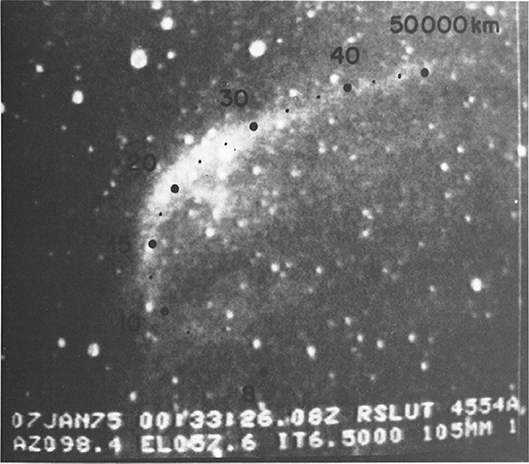
Figure 8. TV frame and theoretical field line from resolute Bay, Northwest Territories at 0033:26 UT. The normal termination at the upper end of the streak (lower right) would near 27,000 km. Note that the apparent end is near 50,000 km. Barium illuminated field line extending to 8 Re altitude. [[18]; reprinted with permission of American Geophysical Union].
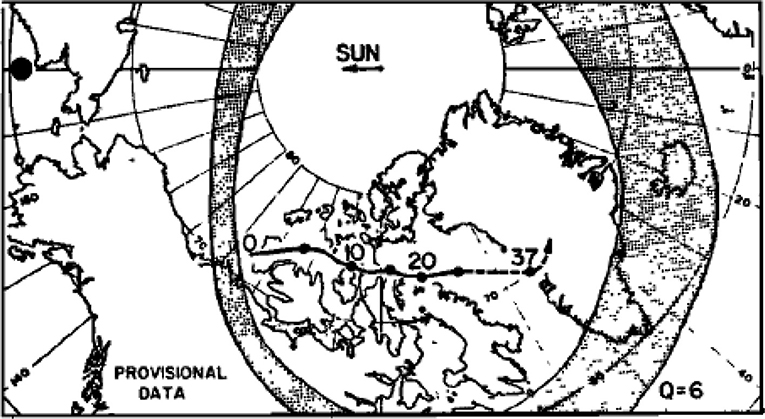
Figure 9. Track of leading tip of ionized barium streak for Tordo I, projected down along magnetic field line to 100 km altitude. Numbers along track are minutes after injection; circles are at 5-min intervals except for 37-min location Dashed line after 25 min reflects present uncertainties requiring additional analysis The statistical auroral oval for a distributed Q = 6 magnetic index is shown as the shaded area. Anti-sunward convection over the polar cap [[19]; reprinted with permission of American Geophysical Union].
Field Line Tracing CAMEO
The next example of field-line tracing is the CAMEO (Chemically Active Materials Ejected from Orbit) experiment of Jim Heppner. Jim told us that he had arranged for thermite barium releases over Alaska from a polar orbiting satellite. We replied that we'd track the barium ions from the lower 48 relying on the magnetic mirror force on the energetic barium ions to overcome gravity and lift the ions upwards along the magnetic field. Indeed, barium streaks photographed from Mount Haleakala, Hawaii and Table Mountain Observatory in California were triangulated measuring the ion motion upwards along the magnetic field line. Figure 10 shows the altitude of the release number two ions as a function of time. Accelerations parallel to B were required to account for the barium ion position as a function of time. In fact, the trajectory indicates up to 6 keV E|| acceleration and deceleration.
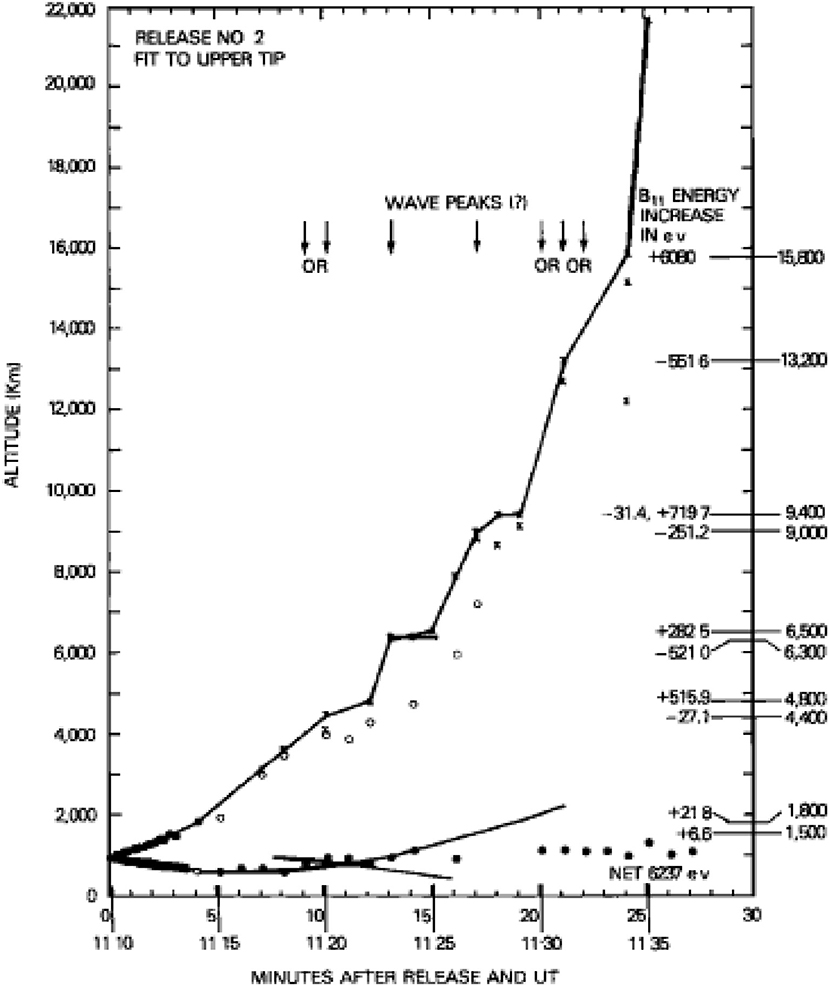
Figure 10. Altitude vs. time plot of CAMEO release No. 2 Trajectory indicates up to 6 keV E|| acceleration and deceleration [[7]; reprinted with permission of American Geophysical Union].
Plasma Depletion Experiments—Waterhole I and III
The Waterhole experiments were ammonium nitrate/nitro methane explosions in the auroral F-region. Charge-exchange/dissociative recombination chemistry removes ions and electrons forming a 50-km diameter “hole” in the ionosphere. The hypothesis was that field-aligned currents connected to auroral arcs are important to the mechanism producing the arc and removing the thermal plasma will perturb the currents and modify the acceleration mechanism [20].
The Waterhole experiments utilized what we learned about depleting the ionosphere following the Skylab launch and Los Alamos' Lagopedo experiments. Releasing tri- atomic molecules in the O+ dominate ionosphere leads to rapid charge-exchange and then dissociative recombination chemistry which removes ions and electrons forming a 50-km diameter “hole” in the ionosphere. It turns out that water (H2O) is a great molecule to release. It turns out that a nitro-methane/ammonium nitrate (basically fuel oil and fertilizer) mixture also works great. You pack the ammonium nitrate into a cylinder and then add the liquid nitro-methane to get the correct stoichiometric balance.
So, in April of 1980 we flew an 88-kilogram ammonium nitrate/nitro-methane explosive into the aurora above Churchill, Canada. Figure 11 shows in situ data obtained by our Canadian partner Whalen et al. [22]. Curve (a) shows rocket altitude and distance from event, curve (b) shows the relative local electron density with a dramatic reduction until the payload flies out of the hole, curve (c) shows the precipitating electron intensity at 0.5 keV again with a dramatic reduction until the payload flies out of the hole, and curve (d) shows the peak column emission intensities of auroral green line. Our question was, “Did we turn off the aurora?”
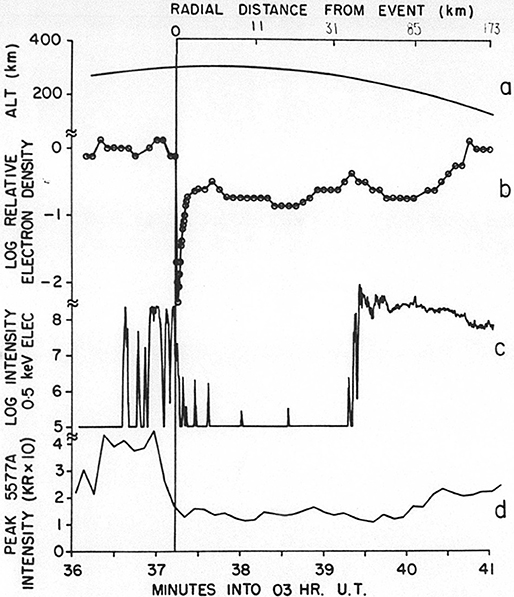
Figure 11. Waterhole I data: (a) Rocket altitude and distance from event, (b) relative local electron density, (c) precipitating electron intensity at 0.5 keV, (d) peak column emission intensities of auroral green line. [[21]; reprinted with permission of American Geophysical Union].
So, with the interesting Waterhole I results we were able to secure funding the try again. By the way Waterhole II suffered a rocket malfunction and the high explosive landed a few kilometers away from our Churchill ground station where the Mounties detonated it with a shaped charge. It turns out that on Waterhole I we detonated the high explosive just north of the auroral field line. For Waterhole III we had additional high explosive and the detonation was controlled from the ground when we encountered the precipitating electron flux.
And, of course, we got different results. The precipitating electron flux at 1.5 keV was enhanced at small pitch angles! Quoting Whalen et al. [21], “The rapid response…and spectrum changes…in energetic electron precipitation indicates…induced electric field must have been large enough to accelerate electrons up to several keV” and “Although the two results appear to be contradictory, simple models…of the structure of auroral arcs seem to be in agreement with both experiments.”
These experiments should be repeated perhaps with the launch of liquid fueled rocket passing perpendicular to an auroral arc. This would ensure that thermal electron currents over the arc and on each side were disrupted. An explosive release creates a deep, localized hole in the F-region. The spatially extended release from a rocket burn would be deep enough but more extensive. An experiment in view of Alaskan incoherent scatter radars and ground based all-sky cameras would provide better diagnostics.
Thermite Barium Releases
Thermite Barium Releases in the Ionosphere
Next, we'll describe our use of thermite barium releases to create a structured plasma. The PLACES (Position Location and Communications Effects Simulations) experiment was a communications field experiment carried out by the Defense Nuclear Agency (DNA) to investigate the effects of structured (striated) ionospheric plasmas on transionospheric communications links (satellite to ground and vice versa). The experiments were carried out in December 1980, at Eglin Air Force Base, Florida. The structured plasma was produced by releasing 48-kg charges of barium thermite near 185-km altitude in the late evening F-region ionosphere on 4 separate days. The resulting barium plasmas form field aligned structures or striations in the ionosphere that simulate important features of the striations produced by debris plasmas resulting from high-altitude nuclear explosions (see Figure 12).
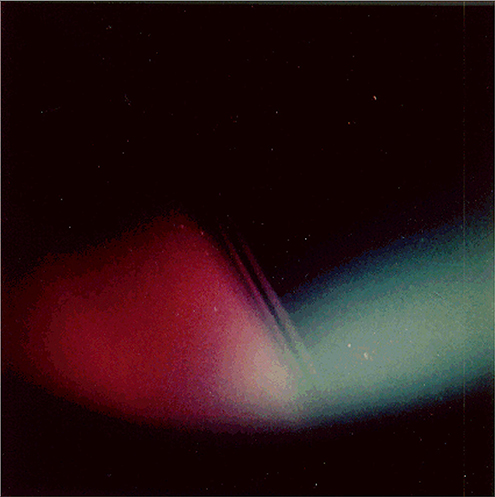
Figure 12. Hope Barium release at T + 20 min. Striated barium ions are reddish and the neutral barium atoms appear as a greenish blue [23].
The primary objectives of the PLACES experiments were to determine, by direct measurement, the phase and amplitude scintillations induced by the disturbed plasma upon satellite signals. Simultaneous measurements of the actual plasma structure and spatial distribution by in situ and remote diagnostics would then define the true plasma configuration. Extensive theoretical work on the relationship between scintillations and plasma structure would then be open to detailed comparison with these data.
The diagnostics include optical measurements of the time evolution of the power spectral density (PSD) of striations for the electron column density perpendicular to the magnetic field and measurements of the time-of-arrival spread of energy (channel impulse response) on a phase coded spread spectrum signal emanating from a rocket launched behind the barium cloud and received at specially constructed ground receiving site in northern Florida (Beacon experiment). The results demonstrated success: the data are shown to be in good agreement with the DNA propagation channel model and a geometric optics interpretation of the observed propagation effects [12, 23].
Thermite Releases at Orbital Velocity
The next active experiment example is the CRRES G-9 experiment, a thermite barium release from the CRRES satellite moving at orbital velocity (about 10 km/s) perpendicular to the local geomagnetic field. This experiment was conducted above the US Virgin Islands on July 19, 1991. A color photograph (Figure 1) showed the dramatic appearance for anyone looking at the right place at the right time. Using the Figure 13 photo Delamere et al. [13] describe the “skid” of the barium ions across the magnetic field. The data on Figure 14 from Szuszczewicz et al. [24] shows the polarization electric field that allowed the barium ions to “skid.” Huba et al. [25] provided a quantitative description of the “skidding.” Rick Rairden's Fabry-Perot data (Figure 3) showed the ions first skidding, and then becoming magnetized and finally thermalizing. Recall that Figure 6 showed electrostatic field enhancements from the kinetic plasma instability [16]. A smorgasbord of plasma physics!
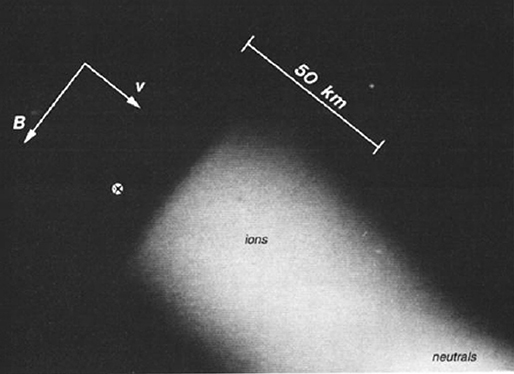
Figure 13. Intensified unfiltered CCD TV image of G9 release 20s after the release (aircraft 127). The edge of the ion cloud is not at the release point (marked with cross) but has “skidded” 18 km along the orbit track. This photo shows the distance the barium ions “skidded” across the magnetic field from the release point before the polarization electric field was neutralized via field- aligned currents reaching down to the more dense ionosphere. [Delamere et al. [13]; reprinted with permission of American Geophysical Union]. The phenomena involved include the polarization “skid” followed by magnetization of the ions and then the formation of ring distribution in velocity space followed by partial thermalization of the ring.
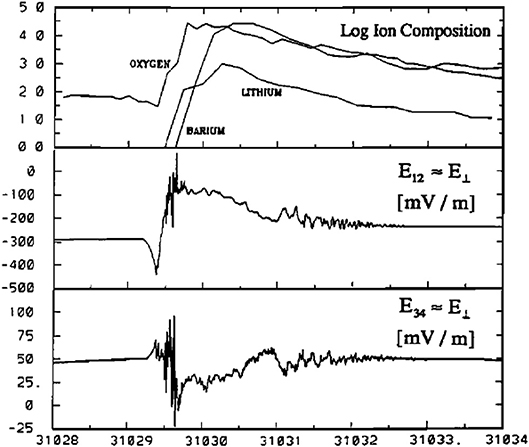
Figure 14. Top Panel: QIMS ion composition data showing O+, LI+, BA+. Middle and bottom panels: Near-perpendicular (E12) and near-parallel-to-(E34)components of the measured electric fields. GMT = 31027 sec is the approximate time of release CRRES release G-9 polarization E-field (middle panel) [[24]; reprinted with permission of American Geophysical Union].
B.E.A.R.—Particle Beam
We'll close with a description of our most “active” active experiment, the B.E.A.R. NPB test conducted in July 1989 from White Sands Missile Range. So, we've gone from Resolute Bay in January to White Sands in July! The B.E.A.R. experiment was in support of President Ronald Reagan's Strategic Defense Initiative (SDI). The challenge was to fly a RFQ accelerator on board a sounding rocket. The accelerator first accelerated negative hydrogen ions to 1 MeV and then passed them through a gas to strip off the electron resulting in a 1-MeV NPB that would propagate across the geomagnetic field. We believe that a 1-MeV beam is the most energetic ever flown in space by about a factor of 30!
Our task was to develop a beam diagnostic package that would measure beam energy, current, divergence, beam composition, beam pointing and beam propagation before stripping. We measured beam pointing well enough to know whether we were aimed at the top or bottom half of the Washington Monument from White Sands. We also monitored spacecraft charging because there was concern that the rocket body would charge up and not allow the beam to propagate away. To do that we alternately turned on and off the neutralizing gas to create a negative ion beam and we also over- neutralized the beam to produce a proton beam. Hugh Christian's electrostatic analyzer measured spacecraft charging [26].
Measuring how far the neutral hydrogen atoms traveled before suffering a stripping colliding with the atmosphere required a bit of trickery. We had no target to shoot at so we relied on the magnetic mirror force to bring the protons back to Ted Fritz's solid-state detector on the rocket. We used the rocket ACS to fire the Ho beam down and east.
Stripping produced protons that mirror and drift up and west back to the rocket. There is a one-to-one relationship between the pitch angle of an observed proton and the distance it traveled as a hydrogen atom before stripping. Figure 15 shows solid-state particle detector (SSD) measurements of the fluence of returning protons and the range of counts predicted by Joe Fitzgerald's Monte-Carlo code.
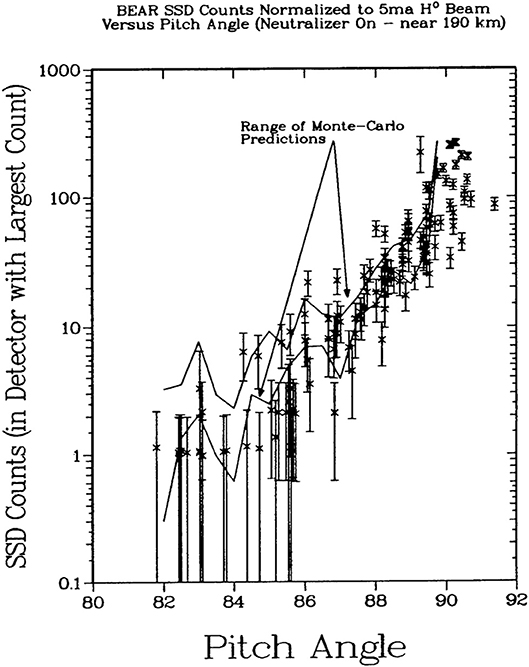
Figure 15. SSD flight data and range of Monte Carlo predictions. Solid-state particle detector (SSD) measurements of the fluence of returning protons were used to estimate the NPB stripping cross section [26].
The experiment successfully demonstrated that a particle beam would operate and propagate as predicted outside the atmosphere and that there are no unexpected side- effects when firing the beam in space.
Epilog
Over the years Los Alamos has successfully employed “hypothesis testing” active experiment techniques to complement their satellite-based “discovery” approach to understanding space plasmas. We urge funding agencies to reinvigorate this method of study.
Author Contributions
The author confirms being the sole contributor of this work and has approved it for publication.
Conflict of Interest Statement
The author declares that the research was conducted in the absence of any commercial or financial relationships that could be construed as a potential conflict of interest.
References
2. United Sates Nuclear Tests: July 1945 through September 1992 (2015). July 1945 through September 1992 (2015). DOE/NV-209-REV16.
3. Bernhardt PA. Probing the magnetosphere using chemical releases from the Combined Release and Radiation Effects Satellite. Phys Fluids B (1992) 4:2249. doi: 10.1063/1.860193
4. Ma TZ and SchunkRW. Ionization and expansion of barium clouds in the ionosphere. J Geophys Res. (1993). 98:323–336.
5. Gonzales VH. Radar Tracking of Barium Ion Clouds: Results of the OLACES Experiment. DNA 5851F (1981).
6. Wescott EM, Reiger EP, Stenbaek-Nielsen HC, David TN, Peek HM., Bottoms PJ. L = 1.24 conjugate magnetic field line tracing experiments with barium shaped charges. J Geophys Res 79:159–68 (1974).
7. Heppner JP, Miller ML, Pongratz MB, Smith LL, Mende SB, et al. The Cameo barium releases: E fields over the polar cap. J Geophys Res Atmosph. (1981) 86:3519–42. doi: 10.1029/JA086iA05p03519
8. Mendillo M, Gerald Hawkins S, John Klobuchar A. A large-scale hole in the ionosphere caused by the Launch of Skylab. Science (1975) 187:343–6. doi: 10.1126/science.187.4174.343
10. O'Shea PG, Butler TA, Lynch MT, McKenna KF, Pongratz MB, Zaugg TJ. A linear accelerator in space – the beam experiment aboard rocket. In: Proceedings of the Linear Accelerator Conference. Albuquerque, NM (1990).
11. Koons HC, Pongratz M. Electric fields and plasma waves resulting from a barium injection experiment. J Geophys Res Atmosph. (1981) 86:1437–46.
12. Fitzgerald Thomas Joseph, David Simons J, Morris Pongratz B, Clynch JR. Occultation of the ATS-3 Satellite by the Avefria Barium Cloud. LA-UR-86–993 (1985).
13. Delamere PA, Stenbaek-Nielsen HC, Hampton DL, Wescott EM. Optical observations of the early (t < 5 s) ion dynamics of the CRRES G1, G9, and GllA releases. J Geophys Res. (1996) 101:17,243–57.
14. Rairden RL, Mende SB, Pongratz MB. Ion Doppler Velocity Distributions Observed in Fabry-Perot Images of CRRES Low-Altitude Barium Releases. Final Report, Artificial Plasma Experiments, NASA-CR-194871 (1994).
15. Simons DJ, Morris Pongratz B, Peter Gary S. Prompt striations in ionospheric barium clouds due to a velocity space instability. J Geophys Res. (1980) 85:671–7.
16. Koons HC, Roeder JL. Observations of ELF fields near the low-altitude CRRES chemical releases. J Geophys Res. (1995) 100:5801–9.
18. Wescott EM, Stenbaek-Nielson HC, Davis TN. The TORDO 1 polar cusp barium plasma injection experiment. J Geophys Res. (1978) 83:1565–75.
19. Jeffries RA, Roach WH, Hones EW Jr, Wescott EM, Stenbaek-Nielson HC, Davis TN et al. Two barium plasma injections into the Northern Magnetospheric Cleft. Geophys Res Lett. (1975) 2:285–8. doi: 10.1029/GL002i007p00285
20. Atkinson G. Auroral arcs: results of the interaction of a dynamic magnetosphere with the ionosphere. J Geophys Res. (1970) 75:4746. doi: 10.1029/JA075i025p04746
21. Whalen BA, Yau AW, Cretuzberg F, Wallis DD, McNamara AG, Harris FR, et al. Waterhole auroral Arc modification experiments: electrodynamic response. J Geophys Res. (1985) 90:8377–86.
22. Whalen BA, Yau AW, Cretuzberg F, Pongratz MB. Waterhole –An auroral- ionosphere perturbation experiment. In: Proceedings of the Chapman Conference on Formation of Auroral Arcs University of Alaska Geophysical Institute. Fairbanks, AK (1980).
23. Simons DJ, Charles Lebeda F, Morris Pongratz B, Joseph Fitzgerald T, Roussel-Dupre R. Evolution of Structure in the PLACES Barium Clouds. LA- 09648-MS (1984).
24. Szuszczewicz EP, Hunton DE, Wygant JR, Schunk RW. Observations and model comparisons of early-time expansion characteristics of a satellite-borne barium-lithium release at F-region altitudes. Geophys Res Lett. (1993) 20:2031–4.
25. Huba JD, Mitchell HG, Fedder JA, Bernhardt PA. Skidding of the CRRES G-9 barium release. Geophys Res Lett. (1992) 19, 1085–8.
Keywords: active experiments, barium, nuclear test, plasma instabilities, CRRES, SDIO, shaped-charge
Citation: Pongratz MB (2018) History of Los Alamos Participation in Active Experiments in Space. Front. Phys. 6:144. doi: 10.3389/fphy.2018.00144
Received: 24 September 2018; Accepted: 30 November 2018;
Published: 18 December 2018.
Edited by:
Joseph Eric Borovsky, Space Science Institute, United StatesReviewed by:
Joseph Huba, Syntek Technologies, Inc., United StatesPaul A. Bernhardt, United States Naval Research Laboratory, United States
Copyright © 2018 Pongratz. This is an open-access article distributed under the terms of the Creative Commons Attribution License (CC BY). The use, distribution or reproduction in other forums is permitted, provided the original author(s) and the copyright owner(s) are credited and that the original publication in this journal is cited, in accordance with accepted academic practice. No use, distribution or reproduction is permitted which does not comply with these terms.
*Correspondence: Morris B. Pongratz, bXBvbmdyYXR6MTk0MkBnbWFpbC5jb20=
 Morris B. Pongratz
Morris B. Pongratz